
Laconia or Lakonia is a historical and administrative region of Greece located on the southeastern part of the Peloponnese peninsula. Its administrative capital is Sparta. The word laconic—to speak in a blunt, concise way—is derived from the name of this region, a reference to the ancient Spartans who were renowned for their verbal austerity and blunt, often pithy remarks.

The Peloponnese, Peloponnesus or Morea is a peninsula and geographic region in Southern Greece, and the southernmost region of the Balkans. It is connected to the central part of the country by the Isthmus of Corinth land bridge which separates the Gulf of Corinth from the Saronic Gulf. From the late Middle Ages until the 19th century, the peninsula was known as the Morea, a name still in colloquial use in its demotic form.

Mystras or Mistras, also known in the Chronicle of the Morea as Myzethras or Myzithras (Μυζηθρᾶς), is a fortified town and a former municipality in Laconia, Peloponnese, Greece. Situated on Mt. Taygetus, above ancient Sparta, and below a Frankish castle, it served as the capital of the Byzantine Despotate of the Morea in the 14th and 15th centuries, experiencing a period of prosperity and cultural flowering during the Palaeologan Renaissance, including the teachings of Gemistos Plethon. The city also attracted artists and architects of the highest quality.

The Mani Peninsula, also long known by its medieval name Maina or Maïna, is a geographical and cultural region in the Peloponnese of Southern Greece and home to the Maniots, who claim descent from the ancient Spartans. The capital city of Mani is Areopoli. Mani is the central of three peninsulas which extend southwards from the Peloponnese. To the east is the Laconian Gulf, to the west the Messenian Gulf. The Mani peninsula forms a continuation of the Taygetos mountain range, the western spine of the Peloponnese.

Morea was the name of the Peloponnese peninsula in southern Greece during the Middle Ages and the early modern period. The name was used for the Byzantine province known as the Despotate of the Morea, by the Ottoman Empire for the Morea Eyalet, and later by the Republic of Venice for the short-lived Kingdom of the Morea.

The Taygetus, Taugetus, Taygetos or Taÿgetus is a mountain range on the Peloponnese peninsula in Southern Greece. The highest mountain of the range is Mount Taygetus, also known as "Profitis Ilias", or "Prophet Elias" (Elijah).
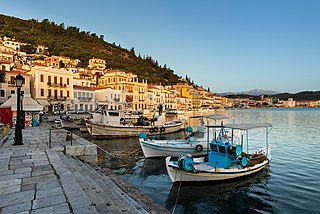
Gytheio or Gythio, also the ancient Gythium or Gytheion, is a town on the eastern shore of the Mani Peninsula, and a former municipality in Laconia, Peloponnese, Greece. Since the 2011 local government reform it is part of the municipality East Mani, of which it is a municipal unit. The municipal unit has an area of 197.313 km2.

Oinountas is a former municipality in Laconia, Peloponnese, Greece. Since the 2011 local government reform it is part of the municipality Sparta, of which it is a municipal unit. The municipal unit has an area of 301.812 km2. The name originates from the Oinountas, a small river that traverses the municipality.

Elos is a village and a former municipality in Laconia, Peloponnese, Greece. Since the 2011 local government reform it is part of the municipality Evrotas, of which it is a municipal unit. The municipal unit has an area of 117.577 km2. It had its own primary school until 2012. The seat of the municipality of Evrota is in Scala. The inhabitants work as farmers producing oranges and olive oil. The municipal unit has a coastline on the Laconian Gulf. The Evrotas River is west of Elos. The name dates back to ancient times. It is located west of Monemvasia, east of Gytheio and southeast of Sparta.

The Evrotas or Eurotas is the main river of Laconia and one of the major rivers of the Peloponnese, in Greece. The river's springs are located just northwest of the border between Laconia and Arcadia, at Skortsinos. The river is also fed by underwater springs at Pellana and by tributaries coursing down from Mt. Taygetos and Mt. Parnon, which flank the Evrotas Valley to the west and east, respectively. The river is 82 kilometres (51 mi) long, flowing in a north-south direction and emptying into the Laconian Gulf. Its drainage basin is 2,239 km2 (864 sq mi).
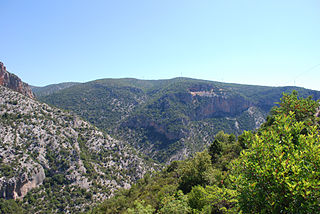
Parnon or Parnonas or Malevos (Μαλεβός) is a mountain range, or massif, on the east of the Laconian plain and the Evrotas Valley. It is visible from Athens above the top of the Argive mountains. The western part is in the Laconia prefecture and the northeastern part is in the Arcadia prefecture. The Parnon range separates Laconia from Arcadia. Its summit offers panoramic views of southeastern Arcadia and South Kynouria and much of Laconia that includes the northern and the central portions and reaches as far as the Taygetos mountains. It also views a part of the central Arcadia and the southern Argolis prefectures. It views the Myrtoan and the Laconian Gulfs.
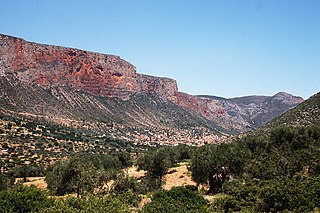
Leonidio is a town and a former municipality in Arcadia, Peloponnese, Greece. Since the 2011 local government reform it is part of the municipality South Kynouria, of which it is a municipal unit. The municipal unit has an area of 418.65 km2, the community 102.67 km2. It is considered a traditional settlement.
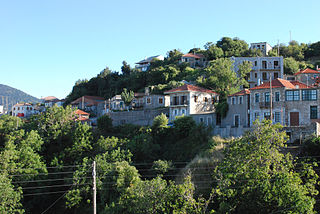
Kosmas is a mountain village and a former community in Arcadia, Peloponnese, Greece. It is considered a traditional settlement. Since the 2011 local government reform it is part of the municipality South Kynouria, of which it is a municipal unit. The municipal unit has an area of 85.220 km2. Kosmas is situated in the southeastern part of the Parnon mountains, at about 1150 m elevation, on the road from Skala (Laconia) to Leonidio. It is 13 km southwest of Leonidio, 28 km east of Sparti, 28 km northeast of Skala, 35 km south of Argos and 57 km southeast of Tripoli. Kosmas has a school, a church and a library.
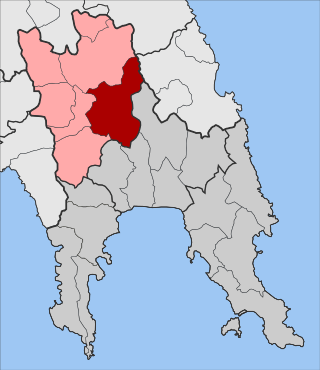
Therapnes is a municipal unit of the municipality (dimos) of Sparti within the regional unit of Laconia in the region (perifereia) of Peloponnese, one of 13 regions into which Greece has been divided. The municipal unit has an area of 261.711 km2. Before 2011 Therapnes was a Demos of Lakonia according to Law 2539 of 1997, the Kapodistria Plan. Its seat was Gkoritsa, which now has no such status. Within its borders lies the ancient town of Therapne.

Krokees is a village and a former municipality in Laconia, Peloponnese, Greece. Since the 2011 local government reform it is part of the municipality Evrotas, of which it is a municipal unit. The municipal unit has an area of 106.930 km2. The population of the community Krokees was 1,029 in 2021. The municipal unit Krokees consists of the communities Krokees, Dafni, Vasilaki and Lagi.
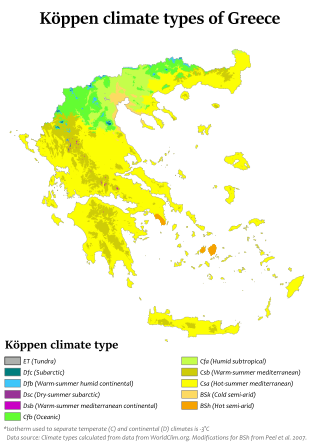
The climate in Greece is predominantly Mediterranean. However, due to the country's geography, Greece has a wide range of micro-climates and local variations. The Greek mainland is extremely mountainous, making Greece one of the most mountainous countries in Europe. To the west of the Pindus mountain range, the climate is generally wetter and has some maritime features. The east of the Pindus mountain range is generally drier and windier in summer. The highest peak is Mount Olympus, 2,918 metres (9,573 ft). The northern areas of Greece have a transitional climate between the continental, the Mediterranean and the humid subtropical climate. There are mountainous areas that have an alpine climate. Also, various areas of Greece have semi-arid climates.

Anavryti or Anavriti (Αναβρυτή) is a small village in Laconia, Greece on Taygetus mountain, altitude 850m. Above the Evrotas Valley, Anavryti is traversed by European walking route E4. It is part of the municipal unit of Mystras.

Vergadeika is a small village within the larger Longanikos community in Laconia, southern Greece. Vergadeika is a one- to two-hour drive to the cities Sparta (34 km), Tripoli (49 km), and Kalamata (58 km). It is approximately 202 km from Athens.

Sparta is a city and municipality in Laconia, Peloponnese, Greece. It lies at the site of ancient Sparta within the Evrotas Valley. The municipality was merged with six nearby municipalities in 2011, for a total population of 32,786, of whom 17,773 lived in the city.
The Battle of Agios Vasileios took place on 22 January 1949. It was fought during the course of Operation Peristera as part of the Greek Civil War, pitting forces of the communist Democratic Army of Greece (DSE) led by Alekos Tsoukopoulos against the nationalist government army under Periklis Papathanasiou.






















